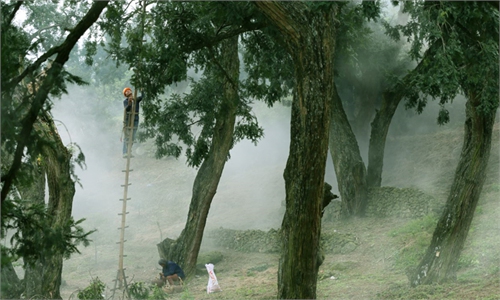A man’s effort of building 34 kilometers green wall with villagers in Xinjiang desert during 41 years

Caption: Fu Zhizhou and his wife Chen Ailan plant trees in Haermodun village of Hejing county, within the Mongolian Autonomous Prefecture of Bayingolin in Xinjiang Uygur Autonomous Region. File photo.
In the heart of Haermodun village of Hejing county, within the Mongolian Autonomous Prefecture of Bayingolin in Xinjiang Uygur Autonomous Region, a striking transformation unfolds against the backdrop of white sands. Towering white poplar trees, standing resolutely like soldiers in formation, create a dense forest that defies the arid landscape. It is hard to imagine that decades ago this region was an utter desert, then a man changed it."These poplar forests, when connected, have a total length of 34 kilometers. They were all planted by my father together with the villagers before his passing," said Fu Guoxi.
It was precisely in this desert plagued by sandstorms that, over the past 41 years, his father, Fu Zhizhou, had planted a total of 800,000 trees. Fu had brought 12,000 mu of desertified land under control and protected 105.33 square kilometers of cultivated land.
The idea of growing trees in the white desert took root in Fu Zhizhou's mind when he tried to grow grains in the sand in 1983. Then the reality dealt a heavy blow. In spring, just as the planted crops had sprouted seedlings, a sandstorm buried them all. Some were even snapped off close to the ground. At the end of the year, there was hardly any harvest.
"At that time, my father thought that if things continued like this, the entire village would be swallowed up by the sand. Living people couldn't be bullied to death by the sand!" Fu Guoxi recalled that his father began planting trees and mobilized the whole family to fight against the desert together with him.
But back then Fu faced ridicule and misunderstanding from some villagers as growing trees in the desert won't bring much economic reward and his family also objected.
Yet Fu Zhizhou remained determined. He and his wife started with the sand dunes beside their own wheat field, hauling sand, leveling the land, and digging holes. Due to financial difficulties, they could only collect branches pruned from other people's orchards for cutting and planting.
They started working before dawn, ate dry naan in the field at noon, and didn't head back until it was after dark.
"What impressed me most when I was a kid was that when the sandstorm attacked, other kids ran back home, but we had to run to the fields," Fu Guoxi recalled. In order to prevent the wind from exposing the roots of the trees, Fu Zhizhou and his family tried to pile up soil around the trees while the wind was blowing.
However, they could not outrun the wind, and some trees still fell. "At that time, I really didn't understand my dad. I thought he cared more about the trees than about his own children," said Fu Guoxi.
Decades later, Fu Zhizhou's effort paid off. More than 66,667 square meters of poplar trees grew into a forest, which made Fu Zhizhou more determined to plant trees in the desert.
According to Fu Guoxi, his father realized at that time it was not enough to just plant trees at the edge of their own farmland — everyone should plant trees together.
Fu Zhizhou's plan to expand tree planting coincided with the introduction of government's financial support for the Three-North Shelterbelt Forest Program (TSFP), a large-scale afforestation initiative.
"In 2003, my father took out a loan to buy bulldozers, tractors, and other equipment, and led the whole family to reclaim wasteland and plant trees," recalled Fu Wenping, another son of Fu Zhizhou.
Driven by Fu Zhizhou's family, more than 300 villagers eventually joined in.
"Fu Zhizhou led the villagers to plant trees stretching 34 kilometers in length, covering nearly 3,000 mu and totaling more than 800,000 trees," said He Qipeng, the director of the villagers' committee of Haermodun village. Over the past 41 years, the vegetation coverage rate in the Shahezi area of Hejing county has soared from 3 percent to 70 percent, and the annual income of the villagers has increased several times over.
After years battling sandstorms, Fu Zhizhou and his wife developed chronic illnesses. Fu Zhizhou's wife Chen Ailan passed away in 2020 due to pneumoconiosis. Fu Zhizhou himself also passed away due to illness in 2024.

Children of Fu Zhizhou plant trees in Haermodun village of Hejing county, within the Mongolian Autonomous Prefecture of Bayingolin in Xinjiang Uygur Autonomous Region on April 25, 2025. Photo: Zhao Yusha/GT
Fu Guoxi vowed to fulfill his father's wish: "There are still 200,000 trees left to reach my father's goal of planting one million trees… my siblings and I may be able to accomplish that within five years or so."Fu Guoxi and his sister Fu Ximei led the Global Times reporter to the first tree their father had planted four decades ago. Now, the white poplar is so large that it took the two of them to encircle it with their arms. "The white poplar is just like my father," said Fu Ximei. "He faced difficulties with unwavering persistence, and his spirit encourages us to do our utmost to fulfill our promises."


